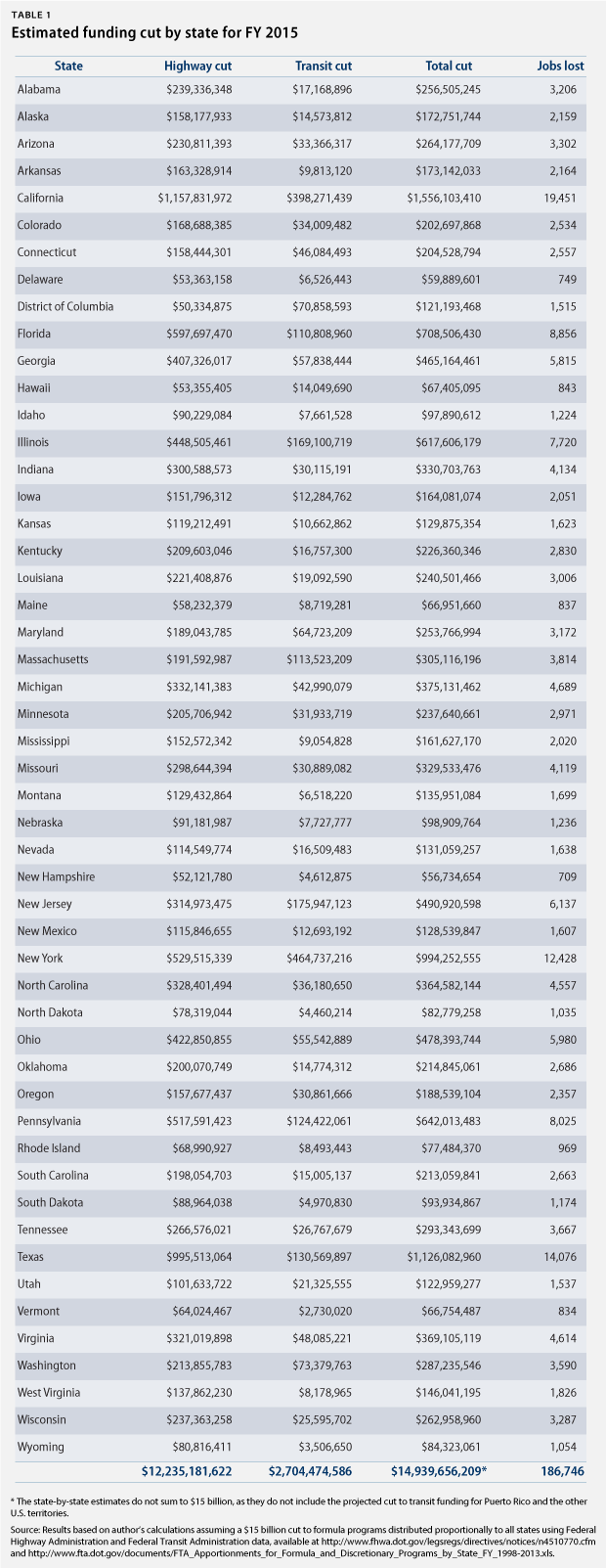Each year, the federal government spends approximately $50 billion on surface transportation programs that support highways, public transportation, and intercity passenger rail. Of this total, $46 billion comes from the Highway Trust Fund, or HTF, which is capitalized by a federal tax of 18.4 cents per gallon on gasoline and 24.4 cents per gallon on diesel.
Dramatic improvements in vehicle fuel efficiency and reduced driving have substantially decreased the amount of gas tax revenue deposited in the HTF each year. In fact, gas tax revenues have fallen so dramatically that since fiscal year 2008, Congress has transferred $54 billion in general fund revenues into the HTF to prevent insolvency. The most recent transfers, authorized as part of the surface transportation bill, Moving Ahead for Progress in the 21st Century, were intended to keep the trust fund healthy through the end of this fiscal year. Unfortunately, current projections show that the highway account will run out of money as early as this August. But the story does not end there.
Under federal law, the HTF cannot run a negative balance. In order to guard against this, the U.S. Department of Transportation, or USDOT, will begin taking special administrative actions this summer during the heart of construction season. Specifically, when the highway account dips below $4 billion, USDOT will either substantially delay payments to states or pay a reduced share—65 cents on the dollar, for example—and special measures will take effect when the mass transit account dips below $1 billion.
The Simpson-Bowles deficit commission called for increasing the gas tax by 15 cents to stabilize the HTF and allow for programmatic growth. Congress must take action soon to avoid bankrupting the fund and hurting our economy.
Inflation and efficiency
Congress last increased the gas tax in 1993, raising it from 14.1 cents to 18.4 cents per gallon; it gave an equivalent raise to diesel. Significant improvements in vehicle efficiency and inflation have combined to lower gas tax revenues and reduce the purchasing power of the remaining dollars:
- In inflation-adjusted terms, the gas tax is worth only 11.5 cents today.
- In 1993, the gas tax represented 18 percent of the cost of an average gallon of gasoline. Today, it represents only 5 percent.
- If gas and diesel taxes had been indexed to keep pace with inflation, today they would be 29 cents and 38 cents per gallon, respectively.
- The corporate average fuel-economy standards will rise to 54.5 miles per gallon for cars and light-duty trucks by model year 2025. This will approximately double the efficiency of vehicles compared to current levels and dramatically reduce the amount of tax revenue flowing to the HTF, crippling federal surface transportation programs.
Twenty years is a long time to wait
Almost everything about our world has changed over the past 20 years—except the federal gas tax. In 1993:
- The average cost of a gallon of gasoline was approximately $1.05.
- Only 23 percent of U.S. households had a computer, and the Census Bureau did not begin asking questions about Internet use for another four years.
- Jurassic Park was the number one movie.
- The European Union was created with the adoption of the Maastricht Treaty.
- The United States had 257 million people and a gross domestic product of 9.5 trillion (compared to 317 million and 15.7 trillion today).
- The North American Free Trade Agreement was signed into law.
- Czechoslovakia became the Czech Republic and Slovakia.
Consequences of inaction
The Congressional Budget Office estimates that the Highway Trust Fund will require $15 billion in additional revenue in FY 2015 to remain solvent and a total of $172 billion over the next 10 years. Research shows that infrastructure investments create strong middle-class jobs, while funding cuts increase unemployment in the construction sector:
- For every $1 billion invested in infrastructure, we create between 10,000 and 15,000 jobs.
- Even with the sustained economic recovery, total employment in heavy-construction industries is down by more than 125,000 jobs, or 13 percent from its pre-recession peak.
- Funding cuts would only make this worse by hitting states during the heart of construction season, causing significant delays, canceled projects, and as many as 185,000 layoffs.
The table below shows the funding cut and potential job loss that each state will face next year if the shortfall is not resolved.

Conclusion
For years, Congress has patched HTF revenue shortfalls with general fund transfers instead of finding a sustainable, long-term funding source to support federal transportation programs for decades to come. The amount of budgetary offsets needed to allow more transfers to make up for falling gas tax revenues will be simply too large moving forward. This fall, Congress has the opportunity to solve the growing funding crisis when it reauthorizes surface transportation programs. Failing to find long-term funding will jeopardize the federal government’s ability to set national transportation policy and serve as a meaningful partner to states and metropolitan regions. Addressing this politically difficult issue will place federal programs on sound fiscal footing and provide them with the resources they need to invest in America’s future.
Kevin DeGood is the Director of Infrastructure Policy at the Center for American Progress.